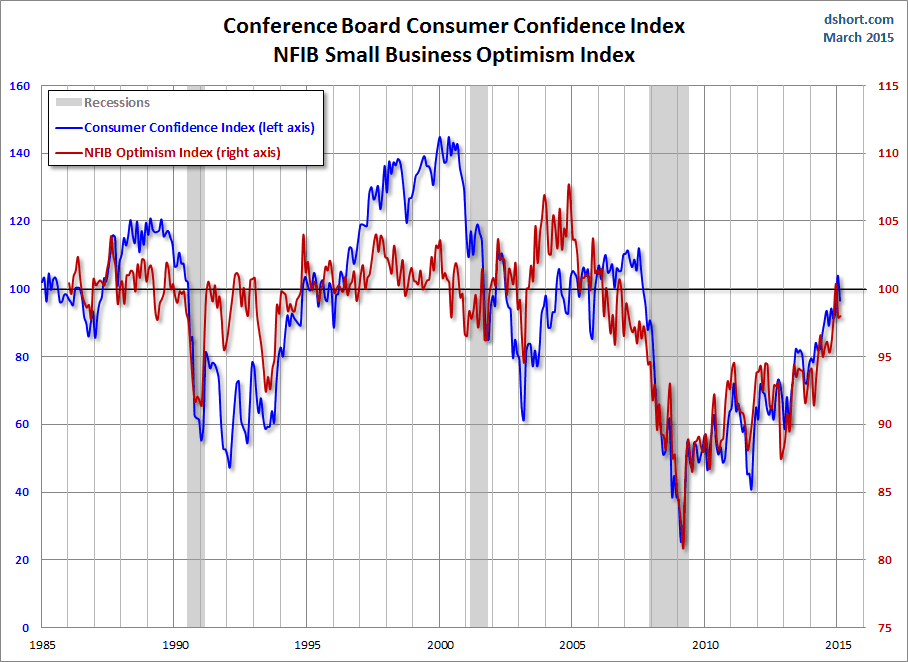The latest issue of the NFIB Small Business Economic Trends is out today. The March update for February came in at 98, a fractional change of 0.1 point from 97.9 the previous month and off the December interim high of 100.4. The index is now at the 37th percentile in this series.
The Investing.com forecast was for 99.2.
Here is the opening summary of the news release.
The Index of Small Business Optimism gained 0.1 points to reach 98.0, the long-term average including the Great Recession and the third highest reading since early 2007. Only eclipsed by November and December 2014 which were a bit higher. Of the ten Index components, the largest gain was in the percent of owners reporting hard-to-fill openings (3 points). Changes were smaller in other components, 2 point increase for inventory investment plans, negative 2 points for job creation plans, and less for the other components. Overall, not a lot of movement in the overall Index or in the components.
The first chart below highlights the 1986 baseline level of 100 and includes some labels to help us visualize that dramatic change in small-business sentiment that accompanied the Great Financial Crisis. Compare, for example the relative resilience of the index during the 2000-2003 collapse of the Tech Bubble with the far weaker readings following the Great Recession that ended in June 2009.

The average monthly change in this indicator is 1.3 points. To smooth out the noise of volatility, here is a 3-month moving average of the Optimism Index along with the monthly values, shown as dots.

Here are some excerpts from the report.
Labor Markets
| Fifty-three percent reported hiring or trying to hire (up 5 points), but 47 percent reported few or no qualified applicants for the positions they were trying to fill. Twelve percent reported using temporary workers, down 2 points. A net 12 percent planning to create new jobs, down 2 points but a solid reading. Twenty-nine percent of all owners reported job openings they could not fill in the current period, up 3 points and the highest reading since April 2006. Fourteen percent cited the availability of qualified labor as their top business problem, the highest since September 2007. The job openings figure is one of the highest in 40 years and this suggests that labor markets are tightening and that there will be more pressure on compensation in the coming months. |
Credit Markets
Has the Fed's zero interest rate policy and quantitative easing had a positive impact on Small Businesses?
| Three percent of owners reported that all their credit needs were not met, holding at an historic low level. Thirty-three percent reported all credit needs met, and 53 percent explicitly said they did not want a loan. Only 3 percent reported that financing was their top business problem (up 1 point) Thirty percent of all owners reported borrowing on a regular basis, down 3 points. |
NFIB Commentary
This month's "Commentary" section includes the following observations:
| The economy lost a lot of momentum in the fourth quarter, with GDP growth now estimated at 2.2 percent (up 2.4 percent for the year) after strong second and third quarter performances. Imports grew substantially, accompanying the huge decline in oil prices. The reduction in oil prices was a great tax cut for the economy, granted by the private sector. Gasoline prices plunged, although recently they have risen steadily, adversely impacting consumer sentiment, mostly due to problems with refining capacity. But gas prices remain much lower than year ago levels, continuing to feed consumer spending and saving. Historically the small business sector produces about half the private GDP and employs half of the private sector workforce. During the recovery, this sector did not pull its historic weight, slowing the recovery in employment substantially. In the boom, not only were too many houses built but too many firms were started, and filled with inventories to satisfy consumer spending driven by a 2 percent saving rate. Huge numbers of firms and their jobs were lost in the recession, nearly 900,000 establishments in each of the years 2008 and 2009. The NFIB data suggest that the surviving firms are regaining stride and the BLS data now show more starts than terminations, supporting job growth. |
Business Optimism and Consumer Confidence
The next chart is an overlay of the Business Optimism Index and the Conference Board Consumer Confidence Index. The consumer measure is the more volatile of the two, so I've plotted it on a separate axis to give a better comparison of the volatility from the common baseline of 100.

These two measures of mood have been highly correlated since the early days of the Great Recession.
